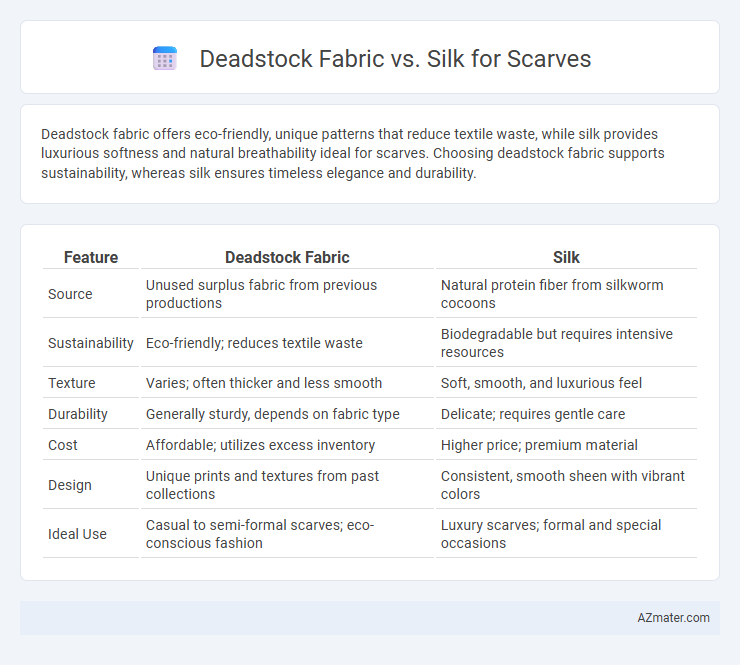Deadstock fabric offers eco-friendly, unique patterns that reduce textile waste, while silk provides luxurious softness and natural breathability ideal for scarves. Choosing deadstock fabric supports sustainability, whereas silk ensures timeless elegance and durability.
Table of Comparison
| Feature | Deadstock Fabric | Silk |
|---|---|---|
| Source | Unused surplus fabric from previous productions | Natural protein fiber from silkworm cocoons |
| Sustainability | Eco-friendly; reduces textile waste | Biodegradable but requires intensive resources |
| Texture | Varies; often thicker and less smooth | Soft, smooth, and luxurious feel |
| Durability | Generally sturdy, depends on fabric type | Delicate; requires gentle care |
| Cost | Affordable; utilizes excess inventory | Higher price; premium material |
| Design | Unique prints and textures from past collections | Consistent, smooth sheen with vibrant colors |
| Ideal Use | Casual to semi-formal scarves; eco-conscious fashion | Luxury scarves; formal and special occasions |
Understanding Deadstock Fabric: What Is It?
Deadstock fabric refers to unused textile materials leftover from previous production runs, often sourced from surplus inventory or discontinued lines, making it an eco-friendly choice for crafting scarves by minimizing waste. Unlike silk, which is a natural protein fiber derived from silkworm cocoons known for its smooth texture and luxurious feel, deadstock fabric encompasses various fabric types including cotton, wool, and synthetics, offering diverse textures and sustainability benefits. Utilizing deadstock fabric for scarves supports circular fashion practices by repurposing high-quality textile remnants, distinguishing it from the traditional single-origin nature of silk.
The Timeless Appeal of Silk for Scarves
Silk scarves exude a timeless appeal due to their natural sheen, smooth texture, and luxurious drape, making them a coveted accessory across generations. Unlike deadstock fabric, which varies widely in quality and origin, silk offers consistent durability and a lightweight feel that enhances comfort and elegance. The intrinsic moisture-wicking properties of silk also contribute to its lasting charm, ensuring scarves remain breathable and suitable for both warm and cool climates.
Sustainability: Deadstock Fabric vs Silk
Deadstock fabric promotes sustainability by repurposing surplus textile waste, significantly reducing landfill contributions and resource consumption associated with new fabric production. Silk, although biodegradable and renewable, involves intensive water, energy, and land use, making its environmental footprint higher compared to deadstock materials. Choosing deadstock fabric for scarves supports circular fashion, minimizes textile waste, and lowers overall environmental impact in sustainable garment creation.
Texture and Feel: Deadstock vs Silk Scarves
Deadstock fabric scarves often offer a unique texture characterized by durability and a slightly stiffer feel due to their vintage or surplus origins, contrasting the smooth, lightweight, and lustrous sensation associated with silk scarves. Silk scarves provide a natural sheen and a soft, breathable texture that drapes effortlessly, enhancing comfort and elegance. Choosing between deadstock fabric and silk involves considering the desired tactile experience, with deadstock emphasizing artisanal uniqueness and silk delivering luxurious softness.
Variety and Uniqueness in Fabric Choices
Deadstock fabric offers unparalleled variety and uniqueness in scarf options due to its limited, often vintage inventory sourced from unused textile remnants, ensuring exclusive patterns and textures unavailable in mainstream markets. Silk scarves, while prized for their smooth texture and luxurious sheen, typically follow seasonal trends and collections, resulting in more predictable and widely available designs. Choosing deadstock fabric allows for environmentally conscious fashion with one-of-a-kind scarves that stand out against the more uniform appeal of traditional silk.
Durability and Care Requirements
Deadstock fabric offers superior durability compared to silk, as it is often made from sturdy, tightly woven materials that resist wear and tear over time. Silk, while luxurious and soft, requires delicate care including hand washing or dry cleaning to maintain its sheen and prevent damage such as snagging or stretching. Choosing deadstock fabric for scarves ensures a longer-lasting accessory with minimal maintenance, whereas silk demands more attentive handling to preserve its elegant appearance.
Price Comparison: Deadstock Fabric vs Silk
Deadstock fabric scarves typically cost 30-50% less than pure silk scarves due to the use of leftover or surplus textile materials, which reduces production expenses. Silk scarves, made from natural protein fibers, command higher prices ranging from $50 to $200 or more per piece, reflecting the labor-intensive harvesting and weaving process. Choosing deadstock fabric offers a budget-friendly, sustainable alternative without compromising style, while silk's premium cost is justified by its luxurious texture and durability.
Environmental Impact and Ethical Considerations
Deadstock fabric reduces textile waste by repurposing surplus or unused materials, minimizing environmental impact through lower resource consumption and waste generation. Silk production involves significant water use, chemical treatments, and ethical concerns regarding silkworm farming and animal welfare. Choosing deadstock fabric supports sustainable fashion by lowering ecological footprint and promoting responsible material reuse compared to conventional silk scarves.
Styling Versatility: Which Fabric Wins?
Deadstock fabric offers unique patterns and sustainable appeal, making each scarf a statement piece perfect for casual and eclectic styles. Silk scarves boast unparalleled softness and a natural sheen, elevating formal and elegant ensembles with classic drape and fluidity. When it comes to styling versatility, silk wins due to its ability to seamlessly transition from casual chic to sophisticated occasions, while deadstock fabric excels in niche, bold fashion statements.
Choosing the Best Fabric for Your Next Scarf
Deadstock fabric offers sustainable, unique patterns and textures ideal for eco-conscious scarf buyers, while silk provides unmatched softness, natural sheen, and breathability favored in luxury accessories. Consider deadstock scarves for durability and one-of-a-kind style that reduces textile waste; choose silk scarves for elegance, hypoallergenic properties, and temperature regulation. Selecting the best fabric depends on your priorities: sustainability and uniqueness with deadstock, or timeless luxury and comfort with silk.

Infographic: Deadstock Fabric vs Silk for Scarf
 azmater.com
azmater.com